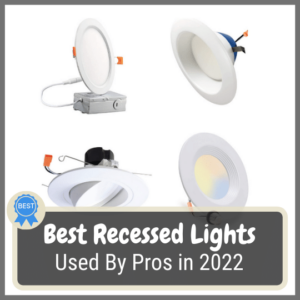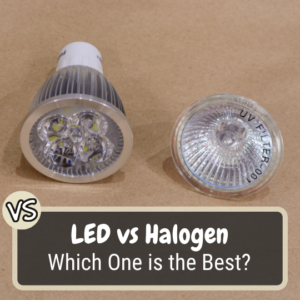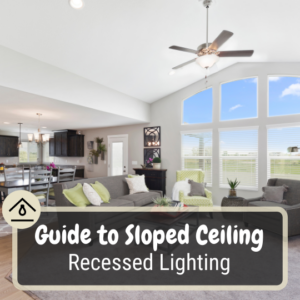Recessed lighting is a standard in new construction, so how much does recessed lighting cost to have installed in an existing home? The answer is it depends on many factors, but the average cost will typically range between $500-$800 for an average bedroom in a single-family home. In this post, I’ll explain the factors that affect how much recessed lighting will cost to have professionally installed by an electrician in your home.
Factors that Affect Lighting Installation Cost
Products and Materials
The cost of the job materials make up a large portion of the total cost of the installation. The products and materials to be installed in your home must meet or exceed building code requirements for safety and efficiency. Cutting costs by using inexpensive materials is never a good idea.
LED Recessed Light Fixtures
The cost of a LED recessed light assembly (housing + LED module) can range from under $20 to well over $60 depending on the specifications, type, and features. Spec-grade LED lights (high quality) will cost more than consumer grade LED lights. With more expensive fixtures, you’re typically paying for better quality electronics, optics, and features like adjustable color temperature and higher light output.
Dimmer Switch
A basic LED dimmer switch will cost around $25 plus the cost of installation. A more advanced “smart” dimmer can range between $45-$75+ and sometimes require additional hardware such as a wireless bridge.
Wire and Other Installation Materials
For most residential installations where the wiring is run in side the wall and ceilings, the electrician will use NM-B copper wire, commonly known as Romex cable. A good contractor will also supply new plastic sheeting to cover and protect the interior of you home from dust.
Labor Costs
One of the biggest expenses of professional installation is the cost of the team. Whether it be a single electrician or a crew, skilled labor in not cheap. Electricians and contractors command high wages, and the time it takes to perform an installation will be a big factor in the overall cost. The longer an installation is estimated to take, the higher the quote will be. The following conditions will affect how long an installation will take:
Ceiling Height
Installing recessed lighting in rooms with tall or vaulted ceilings will take more time than low ceilings. Special equipment such as adjustable ladders or scaffolding may be needed for the installer to safely perform the installation. Setting up and working on top of this equipment will be a cost factor.
What’s above the ceiling?
Attic space is certainly the preference when it comes to running the wires. Even if it’s not accessible, having a space between the ceiling and the roof means the wiring is run on top of the joists rather than drilling through them. This saves a lot of time and minimizes ceiling cuts.
Another room above the ceiling complicates things a little. The wires can’t be run over the joists, so they’ll need to be run through them. This is done by drilling a small hole through each ceiling joist, and fishing the wires through each one across the ceiling. Extreme caution must be taken to prevent accidentally hitting a pipe or anything else that’s running between the floors while drilling. Expect this type of installation to cost more due to the added time and labor.
The roof directly above the ceiling is a similar situation to having a room directly above. It’s especially tough because the ceiling will likely have insulation sandwiched between the ceiling and roof which makes fishing cables even more difficult.
A neighbor (Condo) above you most likely means you have a fire-rated ceiling. The recessed lights will require a fire-rated enclosure to be installed around each one to maintain the fire-rating of the ceiling. This type of ceiling can more than double the cost of having recessed lighting installed in a single family home.
Is the room pre-wired for lighting?
A cable is needed that runs from a wall switch to the recessed lights to power and control them. If an existing ceiling light is being replaced by recessed lights, the existing ceiling light’s circuit can likely be re-purposed for the recessed lighting. If not, a new cable needs to be run across the ceiling, down the wall, and wired to a switch. The cost for this will likely depend on the distance of the run, and whether or not there is attic access above to fish the wiring down the wall.
Use an existing switch or install a new one?
Is there a switch available that can be used for the new recessed lighting? If so, it will usually cost less than if a new one needs to be installed. If there’s a switch that operates a half-hot receptacle, that’s usually a good candidate to re-purpose for your lights.
Ceiling Types
Drywall is the fastest and easiest to work with. Locating ceiling joists through drywall is fairly simple, it’s easy to cut, and for those reasons installation cost can be less than other surfaces.
Plaster walls and ceilings (aka lath and plaster) makes cutting the holes for the lights more difficult and time-consuming than drywall. Plaster is hard and brittle to work with, and cutting holes is often a two-part process; First cutting through the finished plaster layer, and then the wood or metal lath behind it.
Wood ceilings like tongue-and-groove can be difficult and costly to install lights in for two reasons. First, locating the ceiling joists accurately is very difficult through wood, so positioning and finding clearance for the lights can take a lot of time. Second, cutting large round holes through the wood ceiling is tedious and the stakes are high if you make a mistake.
Other Factors that Affect the Overall Cost
There’s a few other factors that may impact the cost of recessed lighting:
Age of the Home
The age of a home can impact the cost of recessed lighting installation. Older homes (Pre-1978) may have asbestos ceilings, lead paint, aluminum wiring, or existing wiring that is inadequate or not up to code – any of which can add cost to the project.
Painting
Paint touch-up is often needed following the installation of new lighting. If rooms have existing lighting that will be removed, those areas where the old lighting has been removed will need to be repaired and painted as well. If you are planning to install recessed lighting as part of a larger remodel, doing things in a logical order can reduce costs. Make sure you have the lighting installed before you paint. Otherwise the electrician may be cutting holes in your newly painted walls and ceilings, and you’ll have to pay the painter to come back and touch them up.
Permit Costs and Fees
Some areas will require a building permit and inspection to install recessed lighting. At minimum, the city inspector will be checking to ensure the electrician installed airtight housings, and that they’re rated for insulation contact. The permit itself will have associated fees that the city charges. In addition, the contractor will likely charge for the administration time it takes to prepare the application and pull the permit.
FAQs about Recessed Lighting Cost
Does recessed lighting add value to your home?
Absolutely. From a functional standpoint, light is necessary for nearly every activity except sleep. Rooms will poor lighting tend to get used less often, so having overhead lighting can really expand the usable living space in a home.
From a resale standpoint, having modern LED recessed lighting like you’d find in a new construction home is very desirable for home buyers.
Does recessed lighting cost less than installing light fixtures?
It depends. If a room already has an electrical box in the ceiling that’s controlled by a wall switch, then you’d only need to factor the cost of the light fixture and the installation. This would almost certainly cost less. If the fixture is basic and you’re handy, it could even be a diy project to install it which would really save money.
On the other hand, if a room does not have wiring for a light fixture in place, then the cost to install recessed lighting in comparison to a light fixture could be very similar.
Does recessed lighting use a lot of electricity?
No, as long as they are LEDs. LED recessed lighting is very energy efficient. If fact, you could light an entire room using LED recessed lights and consume less energy than one halogen light bulb in a table lamp would use. CFL bulbs in recessed lights are also energy efficient, however their poor quality of light and fact that they contain mercury is making them an obsolete technology.
Final Thoughts and Advice
As a recessed lighting installation contractor for nearly two decades, I can’t overemphasize the importance of homeowners getting several estimates from qualified contractors for their project. That said, the purpose is not to get the lowest bid, but rather to have the opportunity to discuss the job with several qualified individuals. By doing this, you’ll gain a better understanding of the process, and how the contractor plans to overcome any obstacles standing in the way of the results you’re looking for.
And lastly, never choose a contractor based on price. If someone is significantly cheaper, there’s always a reason.






